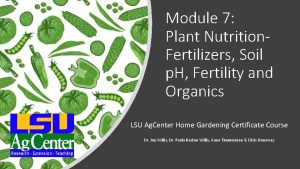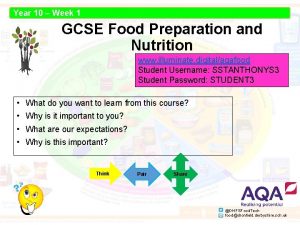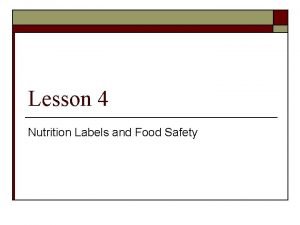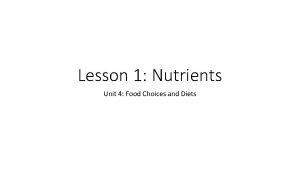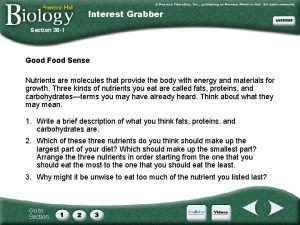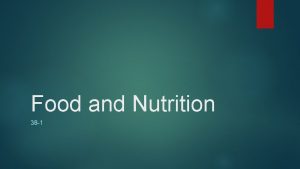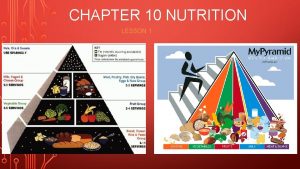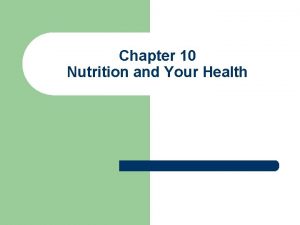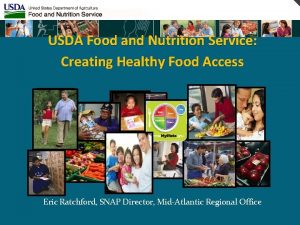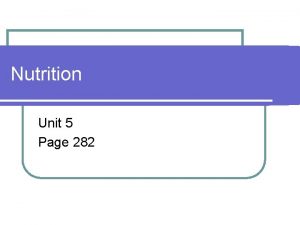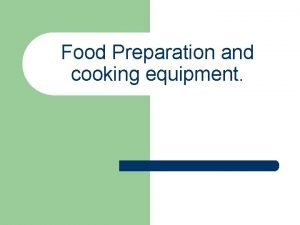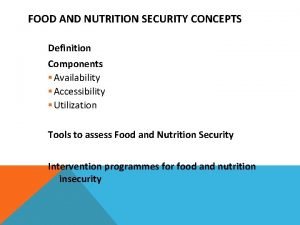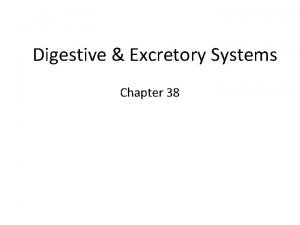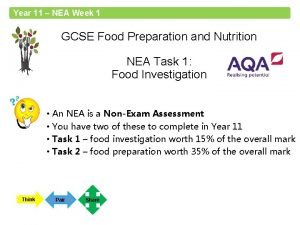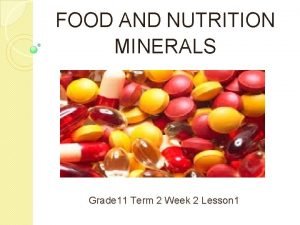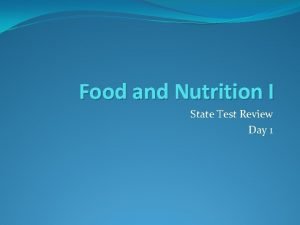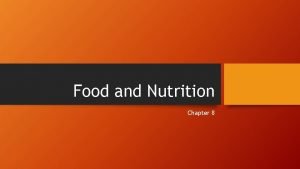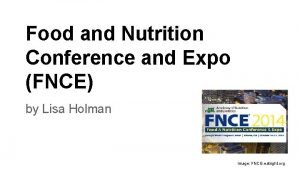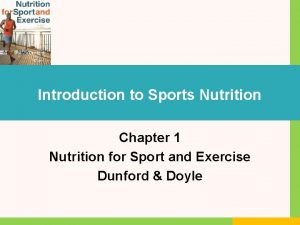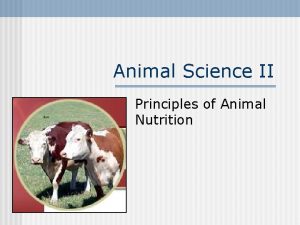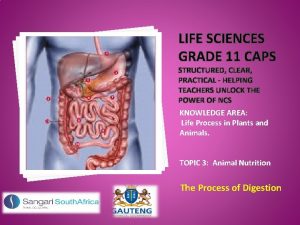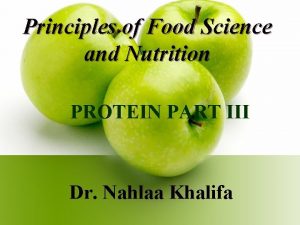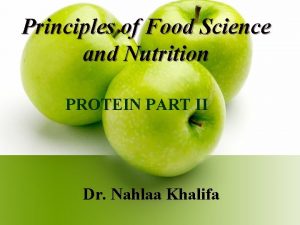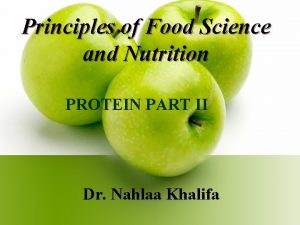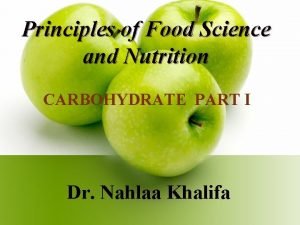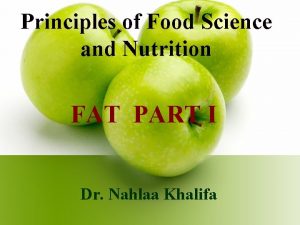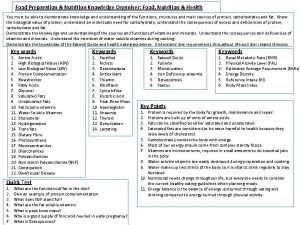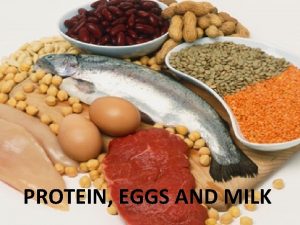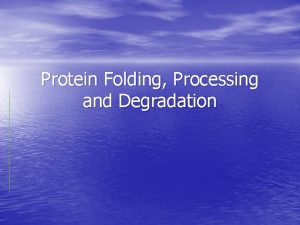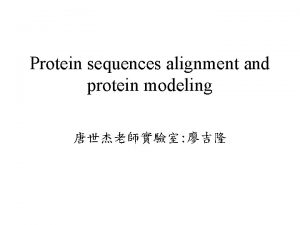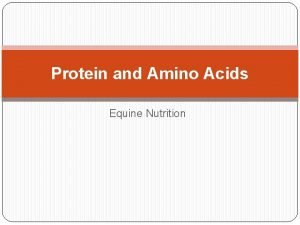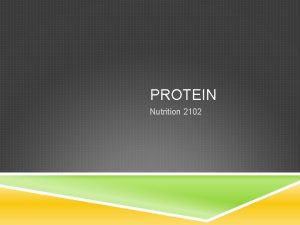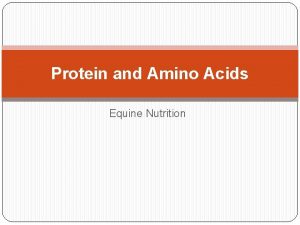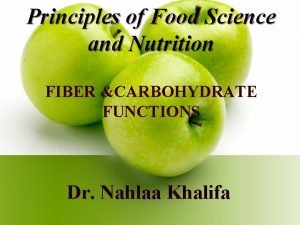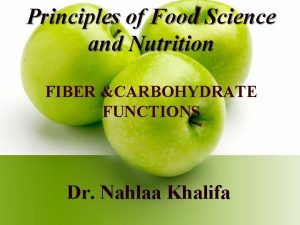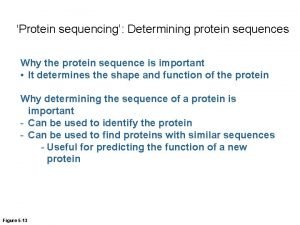Principles of Food Science and Nutrition PROTEIN PART



























- Slides: 27

Principles of Food Science and Nutrition PROTEIN PART I Dr. Nahlaa Khalifa

Nuts Tofu Protein Beans Meat

What is the Nitrogen Cycle? l l The nitrogen cycle represents one of the most important nutrient cycles found in terrestrial ecosystems. Nitrogen is used by living organisms to produce a number of complex organic molecules like amino acids, proteins, and nucleic acids. Despite its abundance in the atmosphere, nitrogen is often the most limiting nutrient for plant growth. This problem occurs because most plants can only take up nitrogen in two solid forms: ammonium ion (NH 4+ ) and the ion nitrate (NO 3 - ). Ammonium is used less by plants for uptake because in large concentrations it is extremely toxic.

Why is Nitrogen Needed? l l All life requires nitrogen. In a never ending “nitrogen cycle” Plants use the nitrogen take up the nitrates to form their own amino acids and convert them to proteins. Animals eat the plants and use the amino acid for tissues Human eat animals and plants for their amino acids and rearrange the nitrogen to make the pattern of amino acids required . Finally everybody dies, organic molecules are degraded by microorganisms , nitrogen goes back into the soil to be used by nitrogen fixed bacteria , and the cycle start again.

The Nitrogen Cycle l Nitrogen is the most abundant element in the atmosphere, but most organisms cannot use it in that form. l Rhizobium bacteria in soil , cyanobacteria in in fresh water, and blue – green algea in sea water have the ability to utilize inorganic nitrogen and “fix” it into organic ammonia.

The Nitrogen Cycle l l Certain plants, like legumes e. g. soybean rely on a special type of bacteria to help them obtain the nitrogen they need. These plants cannot use nitrogen gases in the atmosphere nor can they use the nitrogen compounds in the soil. Nitrogen-fixing bacteria can find a home and moisture in root nodules (little bumps on the roots of plants). A symbiotic relationship is formed , in which the bacteria provide nitrogen , in exchange for sugars and other nutrients from the plant. This accounts for the high nitrogen content in legumes such as soya beans and beans

The Nitrogen Cycle • • • Agricultural practices take advantage of this phenomenon farmers rotate legume crops with corn and wheat to provide added nitrogen to the soil Whereas plant structure is primarily carbohydrate , the structure of humans and animals is built on protein. Deamination is the removal of the amino (nitrogen) from the amino acid – thus creating urea. The remaining deaminated carbon compound can be used to form carbohydrate or fat to produce energy at the rate of 4 kcal/g.

The Nitrogen Cycle • • Protein in muscles and body tissues is in constant turnover. Tissue protein is degraded and nitrogen excreted in the urine and new protein is required daily to maintain the body in steady state. An energy deficit or an inadequate protein intake may force the body to use amino acids as fuel creating a negative nitrogen balance. Protein eaten in excess of need is degraded and stored as body fat.

The Nitrogen Balance 1. Zero Nitrogen Balance 2. Positive nitrogen balance. 3. Negative nitrogen balance

Zero Nitrogen Balance Nitrogen intake equals nitrogen excreted or Protein made = protein broken down l Anabolism = catabolism l Most adults are in zero nitrogen balance l

Positive nitrogen balance l l l exists when nitrogen intake exceeds amount excreted or Making more protein than breaking down Anabolism > catabolism It occur in a. Pregnancy b. Growth periods Infants and children c. Building muscle Athletes d. Rebuilding tissue after trauma/illness

Negative nitrogen balance l l l Exists when more nitrogen is lost than taken in. or Breaking down more protein than you are making Catabolism > anabolism It occur in a. Fever b. Injury c. Surgery d. Burns e. Starvation f. Immobilization


Proteins: The Basis of Body Structure l Protein =Proteins are the most structurally sophisticated molecules known, and all are polymers constructed from the same set of 20 amino acids. Polymers of amino acids are called polypeptides l Proteins form key parts of the body’s main structural components—muscles and bones—and of blood, enzymes, cell membranes, and some hormones

Elementary Composition of Proteins Chemical composition: l primarily carbon, hydrogen, oxygen Additional difference: contain a fairly constant amount of nitrogen found in amino groups (17%) l many also contain sulfur, phosphorus and iron l structure is typically complex, having high molecular weight

Amino acids • Amino acids are organic molecules possessing both carboxyl groups and amino Types of amino acids : 1. 2. 3. Essential amino acids Nonessential amino acids Conditionally Essential amino acids

1. Essential Amino Acids l 1. 2. 3. 4. 5. 6. 7. 8. 9. There are 9 amino acids in total Valine Lycin Methionine Phenylalanine Threonine Tryptophan Isoleucine Leucine Histidin (required for children)

1. Essential Amino Acids l i. iii. l Called essential because; You must get them from your diet They are essential for life & growth The body is NOT able to produce these nine Amino acids. Found in animal protein food sources*except Soy proteins

2. Non - Essential Amino Acids l Are the 13 amino acids that can synthesized by the body in adequate amount and they are as follow : 1. Glutamin 2. Glycine 3. Hydroxyproline 4. Proline 5. Serine 6. Tyrosine 7. Alanine 8. Arginine 9. Asparagine 10. Aspartic acid 11. Cysteine 12. Cystine 13. Glutamic acid

3. Conditionally Essential Amino Acids l Sometimes non-essential amino acids become essential under special circumstances e. g. the body use essential amino acids phenylalanine to make tyrosine (non-essential). If the diet fail to supply enough phenylalanine or if the body can not make conversion for some reasons (inherited disease phenyleketonuria)

Complete and Incomplete Proteins Biological value : l Is the term describes how well a particular protein food approximate the amount and combination of essential amino acids in the body. Types of protein: l There are tow types of protein 1. Complete protein 2. Incomplete protein

Complete and Incomplete Proteins l l Complete proteins or higher quality proteins come from foods containing all of the essential amino acids in the quantity and correct ratio to maintain nitrogen balance and allow for tissue growth and repair. Sources are; Meat, fish, poultry, eggs, milk, cheese, and soy Incomplete proteins or lower quality proteins lack ore or more of the essential amino acid. Incomplete protein diets will eventually lead to protein malnutrition. Sources are ; Plants, including legumes, grains, and nuts

Complete and Incomplete Proteins l Generally speaking , animal sources of protein such as meat, fish, poultry and dairy product contain complete proteins of high biological value. Incomplete yet good sources of protein food that are lacking one or more of the essential amino acids include plant sources ; whole grains, legumes , nuts and seeds.

Complementary Proteins l Occurs when a combination of sources of incomplete / low quality proteins are eaten in the same day to make a complete protein l Examples: corn and beans, rice and lentils , bread and peanut butter, bread and split pea soup, bread and cheese, bread and baked beans, macaroni and cheese, cereal and milk tortillas and beans

Complementary Proteins l Combining incomplete protein foods over the course of the day can give the body all of the essential amino acids needed for adequate protein status. Therefore , vegetarians can receive adequate protein without eating meat if food choices are made wisely

Complementary Proteins

Complementary Proteins
 Carrier vs channel proteins
Carrier vs channel proteins Protein-protein docking
Protein-protein docking Math is my favourite subject
Math is my favourite subject Natural fertilizer disadvantages
Natural fertilizer disadvantages Gcse food tech high skill dishes
Gcse food tech high skill dishes Datingoo
Datingoo Food and nutrition unit 4
Food and nutrition unit 4 Section 38-1 food and nutrition
Section 38-1 food and nutrition Rda food label
Rda food label 38-1 food and nutrition
38-1 food and nutrition Chapter 10 nutrition for health lesson 1 answer key
Chapter 10 nutrition for health lesson 1 answer key Chapter 10 lesson 4 nutrition labels and food safety
Chapter 10 lesson 4 nutrition labels and food safety Usda food and nutrition service
Usda food and nutrition service Food and nutrition unit 5
Food and nutrition unit 5 Advantages of labour saving devices in the kitchen
Advantages of labour saving devices in the kitchen Nutrition security meaning
Nutrition security meaning Section 38-1 food and nutrition
Section 38-1 food and nutrition Nea 1 food preparation and nutrition example
Nea 1 food preparation and nutrition example Food and nutrition grade 11
Food and nutrition grade 11 Food and nutrition 2 state test review
Food and nutrition 2 state test review Chapter 8 food and nutrition
Chapter 8 food and nutrition Food and nutrition expo
Food and nutrition expo Unit 2 food food food
Unit 2 food food food Food chain food chain food chain
Food chain food chain food chain Sports nutrition definition
Sports nutrition definition Principles of animal science
Principles of animal science Grade 11 animal nutrition
Grade 11 animal nutrition Business modeling olympiad
Business modeling olympiad



